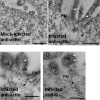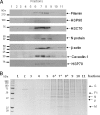Protein analysis of purified respiratory syncytial virus particles reveals an important role for heat shock protein 90 in virus particle assembly
- PMID: 20530633
- PMCID: PMC2938102
- DOI: 10.1074/mcp.M110.001651
Protein analysis of purified respiratory syncytial virus particles reveals an important role for heat shock protein 90 in virus particle assembly
Abstract
In this study, we used imaging and proteomics to identify the presence of virus-associated cellular proteins that may play a role in respiratory syncytial virus (RSV) maturation. Fluorescence microscopy of virus-infected cells revealed the presence of virus-induced cytoplasmic inclusion bodies and mature virus particles, the latter appearing as virus filaments. In situ electron tomography suggested that the virus filaments were complex structures that were able to package multiple copies of the virus genome. The virus particles were purified, and the protein content was analyzed by one-dimensional nano-LC MS/MS. In addition to all the major virus structural proteins, 25 cellular proteins were also detected, including proteins associated with the cortical actin network, energy pathways, and heat shock proteins (HSP70, HSC70, and HSP90). Representative actin-associated proteins, HSC70, and HSP90 were selected for further biological validation. The presence of beta-actin, filamin-1, cofilin-1, HSC70, and HSP90 in the virus preparation was confirmed by immunoblotting using relevant antibodies. Immunofluorescence microscopy of infected cells stained with antibodies against relevant virus and cellular proteins confirmed the presence of these cellular proteins in the virus filaments and inclusion bodies. The relevance of HSP90 to virus infection was examined using the specific inhibitors 17-N-Allylamino-17-demethoxygeldanamycin. Although virus protein expression was largely unaffected by these drugs, we noted that the formation of virus particles was inhibited, and virus transmission was impaired, suggesting an important role for HSP90 in virus maturation. This study highlights the utility of proteomics in facilitating both our understanding of the role that cellular proteins play during RSV maturation and, by extrapolation, the identification of new potential targets for antiviral therapy.
Figures











Similar articles
-
A Proteomic-Based Workflow Using Purified Respiratory Syncytial Virus Particles to Identify Cellular Factors as Drug Targets.Methods Mol Biol. 2016;1442:175-94. doi: 10.1007/978-1-4939-3687-8_13. Methods Mol Biol. 2016. PMID: 27464695
-
Dimerization of matrix protein is required for budding of respiratory syncytial virus.J Virol. 2015 Apr;89(8):4624-35. doi: 10.1128/JVI.03500-14. Epub 2015 Feb 11. J Virol. 2015. PMID: 25673702 Free PMC article.
-
Respiratory syncytial virus assembles into structured filamentous virion particles independently of host cytoskeleton and related proteins.PLoS One. 2012;7(7):e40826. doi: 10.1371/journal.pone.0040826. Epub 2012 Jul 13. PLoS One. 2012. PMID: 22808269 Free PMC article.
-
Central role of the respiratory syncytial virus matrix protein in infection.FEMS Microbiol Rev. 2006 Sep;30(5):692-705. doi: 10.1111/j.1574-6976.2006.00025.x. FEMS Microbiol Rev. 2006. PMID: 16911040 Review.
-
Chaperoning the Mononegavirales: Current Knowledge and Future Directions.Viruses. 2018 Dec 8;10(12):699. doi: 10.3390/v10120699. Viruses. 2018. PMID: 30544818 Free PMC article. Review.
Cited by
-
Current approaches on viral infection: proteomics and functional validations.Front Microbiol. 2012 Nov 16;3:393. doi: 10.3389/fmicb.2012.00393. eCollection 2012. Front Microbiol. 2012. PMID: 23162545 Free PMC article.
-
Binding of respiratory syncytial virus particles to platelets does not result in their degranulation in vitro.Access Microbiol. 2023 Jul 13;5(7):acmi000481.v3. doi: 10.1099/acmi.0.000481.v3. eCollection 2023. Access Microbiol. 2023. PMID: 37601435 Free PMC article.
-
Proteomic analysis of virus-host interactions in an infectious context using recombinant viruses.Mol Cell Proteomics. 2011 Dec;10(12):M110.007443. doi: 10.1074/mcp.M110.007443. Epub 2011 Sep 12. Mol Cell Proteomics. 2011. PMID: 21911578 Free PMC article.
-
Imaging analysis of human metapneumovirus-infected cells provides evidence for the involvement of F-actin and the raft-lipid microdomains in virus morphogenesis.Virol J. 2014 Nov 19;11:198. doi: 10.1186/s12985-014-0198-8. Virol J. 2014. PMID: 25408253 Free PMC article.
-
Identification of Cytoplasmic Chaperone Networks Relevant for Respiratory Syncytial Virus Replication.Front Microbiol. 2022 May 9;13:880394. doi: 10.3389/fmicb.2022.880394. eCollection 2022. Front Microbiol. 2022. PMID: 35615506 Free PMC article.
References
-
- Grosfeld H., Hill M. G., Collins P. L. (1995) RNA replication by respiratory syncytial virus (RSV) is directed by the N, P, and L proteins; transcription also occurs under these conditions but requires RSV superinfection for efficient synthesis of full-length mRNA. J. Virol. 69, 5677–5686 - PMC - PubMed
Publication types
MeSH terms
Substances
Grants and funding
LinkOut - more resources
Full Text Sources
Other Literature Sources
Miscellaneous

